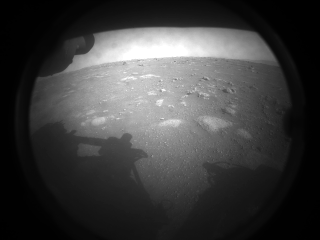
MISSION TO MARS. Filipino-American Gregorio Villar III, an engineer at NASA, is part of the Mars 2020 mission that successfully launched America's largest and most advanced rover called Perseverance to the Red Planet. The rover touched down on Mars' Jazero Crater on Friday (Feb. 19, 2021, Philippine time). (Photo courtesy of the US Embassy in Manila/NASA Mars Exploration Program)
MANILA – Filipino-American engineer Gregorio Villar III was one of those who assisted in the safe landing of the National Aeronautics and Space Administration's (NASA) Perseverance rover on Mars, the United States Embassy in Manila said Friday.
"As we celebrate the successful landing of NASA's Perseverance rover on Mars, did you know that Fil-Am engineer Gregorio Villar III helped with its safe landing as the Entry, Descent, and Landing (EDL) Systems Engineer of the Mars 2020 mission?" it said in its official Twitter account.
He works as an EDL Systems engineer at NASA's Jet Propulsion Laboratory (JPL).
According to his profile at the agency, Villar spent seven-and-a-half years building and testing a system that would land a car-sized rover on Mars.
He is also the head verification and validation engineer for the EDL phase of Perseverance.
Among others, Villar directed a Mars parachute test campaign at NASA's Ames Research Center, the world's largest wind tunnel.
For the Mars 2020 mission, he also led a council of atmospheric scientists from institutions around the world to characterize the Martian atmosphere.
Villar was awarded a NASA scholarship in his junior year of college, which came with an internship at a NASA center of his choice.
"I started interning at JPL in 2010 and got hired full-time in 2012," he said in his reflections posted at the NASA Mars Exploration Program website.
For Villar, what excites him about Mars and space exploration is the "thought of going there" himself one day.
He studied at Saint Louis University-Laboratory High School in Baguio City and earned his bachelor's degree in physics from the California State Polytechnic University in Pomona and his master's degree in astronautical engineering from the University of Southern California.
'Touchdown'
Launched in June 2020 from Cape Canaveral Space Force Station in Florida, Perseverance is described as the "largest, most advanced" rover NASA has sent to another world.
After a seven-month-long journey, it successfully touched down on the Jezero Crater in Mars on Friday, marking an ambitious first step in the effort to collect samples from the Red Planet and return them to Earth.

The rover was launched to investigate the rock and sediment of Jezero’s ancient lakebed and river delta to characterize the region’s geology and past climate.
However, it would undergo several weeks of testing before it begins its two-year science investigation of Mars’ Jezero Crater.
A fundamental part of its mission is astrobiology, including the search for signs of ancient microbial life.
“This landing is one of those pivotal moments for NASA, the United States, and space exploration globally – when we know we are on the cusp of discovery and sharpening our pencils, so to speak, to rewrite the textbooks,” acting NASA Administrator Steve Jurczyk said.
Scientists believe that the Jezero Crater, which sits on the western edge of a giant impact basin called Isidis Planitia just north of the Martian equator, "had its own river delta and was filled with water" some 3.5 billion years ago.
“Perseverance is the first step in bringing back rock and regolith from Mars. We don’t know what these pristine samples from Mars will tell us. But what they could tell us is monumental – including that life might have once existed beyond Earth,” said Thomas Zurbuchen, associate administrator for science at NASA. (PNA)
